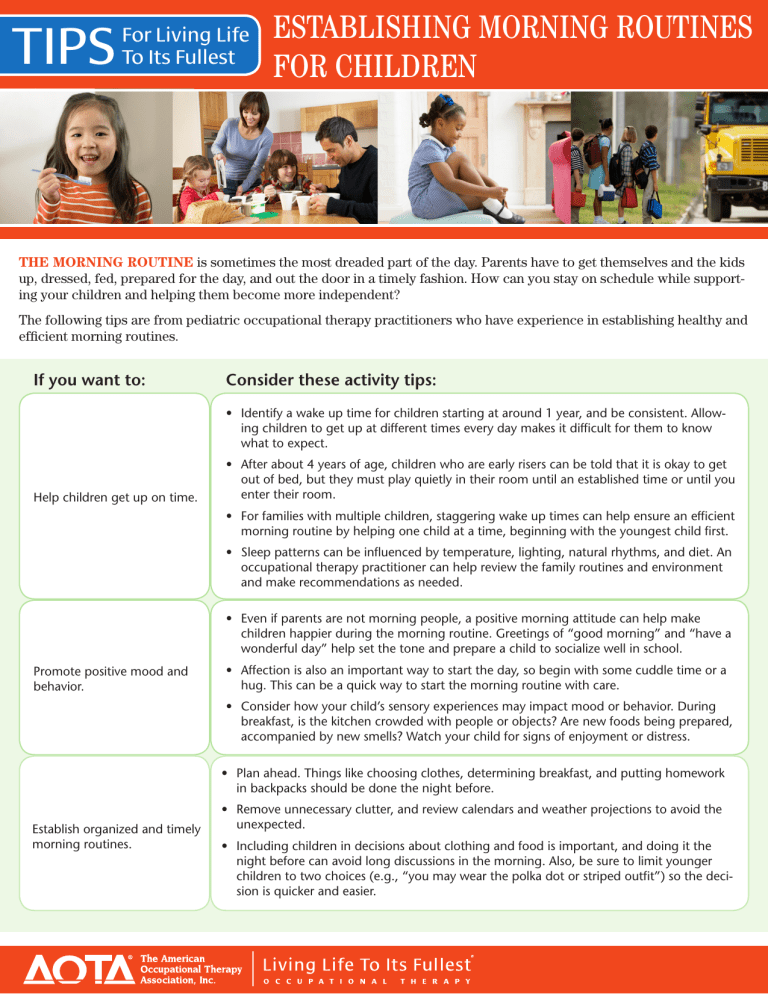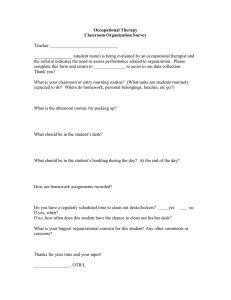
TIPS For Living Life To Its Fullest ESTABLISHING MORNING ROUTINES FOR CHILDREN THE MORNING ROUTINE is sometimes the most dreaded part of the day. Parents have to get themselves and the kids up, dressed, fed, prepared for the day, and out the door in a timely fashion. How can you stay on schedule while supporting your children and helping them become more independent? The following tips are from pediatric occupational therapy practitioners who have experience in establishing healthy and efficient morning routines. If you want to: Consider these activity tips: • Identify a wake up time for children starting at around 1 year, and be consistent. Allowing children to get up at different times every day makes it difficult for them to know what to expect. Help children get up on time. • After about 4 years of age, children who are early risers can be told that it is okay to get out of bed, but they must play quietly in their room until an established time or until you enter their room. • For families with multiple children, staggering wake up times can help ensure an efficient morning routine by helping one child at a time, beginning with the youngest child first. • Sleep patterns can be influenced by temperature, lighting, natural rhythms, and diet. An occupational therapy practitioner can help review the family routines and environment and make recommendations as needed. • Even if parents are not morning people, a positive morning attitude can help make children happier during the morning routine. Greetings of “good morning” and “have a wonderful day” help set the tone and prepare a child to socialize well in school. Promote positive mood and behavior. • Affection is also an important way to start the day, so begin with some cuddle time or a hug. This can be a quick way to start the morning routine with care. • Consider how your child’s sensory experiences may impact mood or behavior. During breakfast, is the kitchen crowded with people or objects? Are new foods being prepared, accompanied by new smells? Watch your child for signs of enjoyment or distress. • Plan ahead. Things like choosing clothes, determining breakfast, and putting homework in backpacks should be done the night before. Establish organized and timely morning routines. • Remove unnecessary clutter, and review calendars and weather projections to avoid the unexpected. • Including children in decisions about clothing and food is important, and doing it the night before can avoid long discussions in the morning. Also, be sure to limit younger children to two choices (e.g., “you may wear the polka dot or striped outfit”) so the decision is quicker and easier. If you want to: Prepare children for morning time demands. Keep on task. Consider these activity tips: • Talk to your children the night before about what will happen each morning. Ask them to name the steps of the morning routine. • Reviewing the morning routine helps to reinforce it. In the morning as they complete a task, ask them what is next. • Creating a visual checklist can help a child participate in the morning routine. Spend a weekend afternoon creating a checklist with your child so he or she gets excited about using it. Ask for suggestions on what to include and ask him or her to draw pictures for each step. As the child ages, you may update the checklist to avoid boredom. • Help avoid distractions by leaving the television off in the morning. • It may be faster and easier to dress children or do their hair, but it is important for them to practice and learn to engage in the morning routine independently. Promote participation and independence. • Allow children to dress independently on weekends and then progress to weekdays as they become more skilled. Start with a certain aspect of dressing, like putting on socks, then add more complicated clothing, like shirts with buttons. It is okay to let them go to school with a unique outfit or hairdo! • Despite the importance of structure and routine, there are some days, like weekends and holidays, where the routine can be relaxed. Promote flexibility as well as structure. • Plan pajama days or fun breakfast times on weekends and holidays to let your children know that sometimes the routine can be changed. • Remember, fun and play are important ways to promote a child’s healthy development. Make morning routines fun. • If routines are fun, children will be more engaged. Think about being creative with dressing and grooming activities. Play upbeat music while children are getting dressed. If they get dressed early, allow them to play with a special toy. Reward them for a job well done. Need More Information? Pediatric occupational therapy practitioners promote participation of all children and their families in everyday activities or occupations, including morning routines. When there is a particular area of concern, the occupational therapy practitioner can create an individualized strategy based on the specific needs of the child and family. Occupational therapy practitioners work with children in their homes, at school, in private practice, at children’s hospitals, and in other community locations, providing interventions that are individualized, appropriate, and effective. Ask your pediatrician or school administrator for a recommendation, or look online to find an occupational therapist in your area. You can find additional information through the American Occupational Therapy Association (AOTA) at www.aota.org. AOTA thanks Joy Doll, OTD, OTR/L, for her assistance with this Tip Sheet. Occupational therapy is a skilled health, rehabilitation, and educational service that helps people across the lifespan participate in the things they want and need to do through the therapeutic use of everyday activities (occupations). Copyright © 2013 by the American Occupational Therapy Association. This material may be copied and distributed for personal or educational uses without written consent. For all other uses, contact copyright@aota.org.
